Commanders!
Spanning a wide range of designs, roles, and technological advancements, we captured the history of British wheeled medium tanks with rare and stunning images digitalized for us by the Tank Museum.
Discover the process of bringing these historical marvels into the World of Tanks and follow us on their journey from their inception to the present day.
Introduction
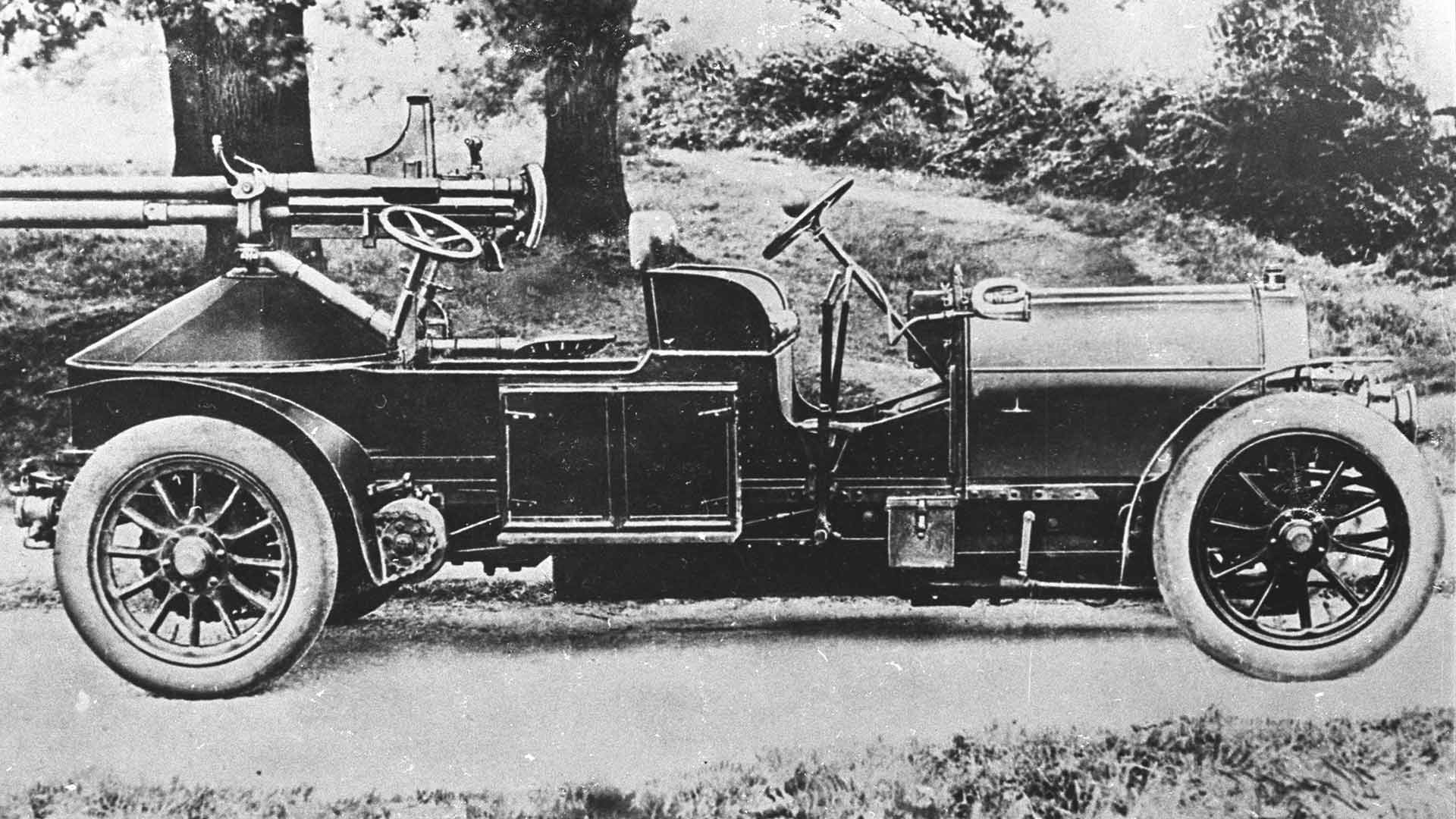 A Driggs-Shroeder automatic cannon on a special Maudslay demonstration vehicle.
A Driggs-Shroeder automatic cannon on a special Maudslay demonstration vehicle.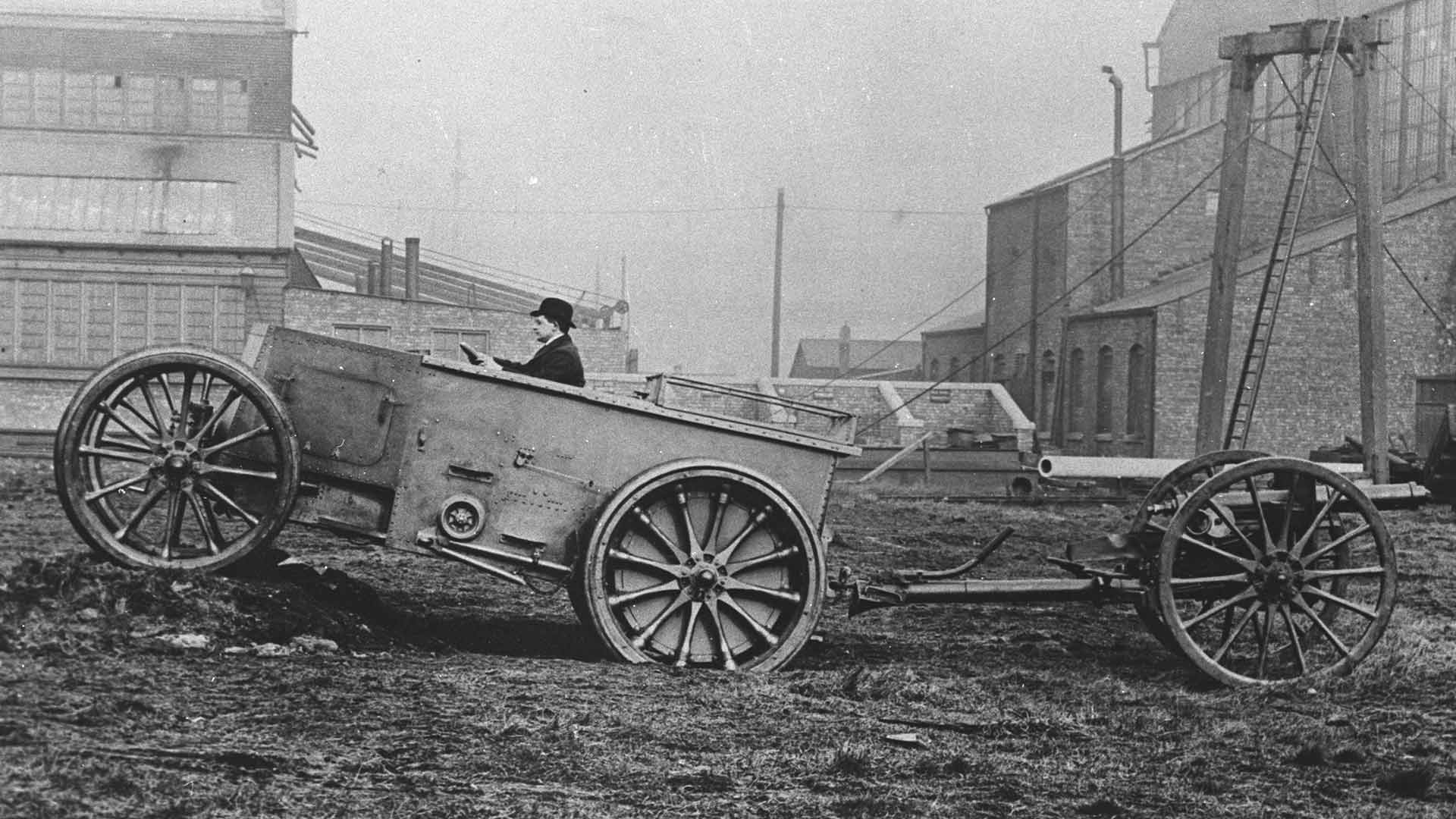 The Armstrong-Whitworth armoured car outside the Elswick works, Notice the similarity between its front wheel and those of the gun.
The Armstrong-Whitworth armoured car outside the Elswick works, Notice the similarity between its front wheel and those of the gun.The concept of wheeled vehicles for military use was hatched in the early 20th century. As they were initially used for transportation and logistics, the British military recognized their potential for reconnaissance, communication, and rapid deployment. Early models often featured open-top designs, limited armor, and relatively simple armament.
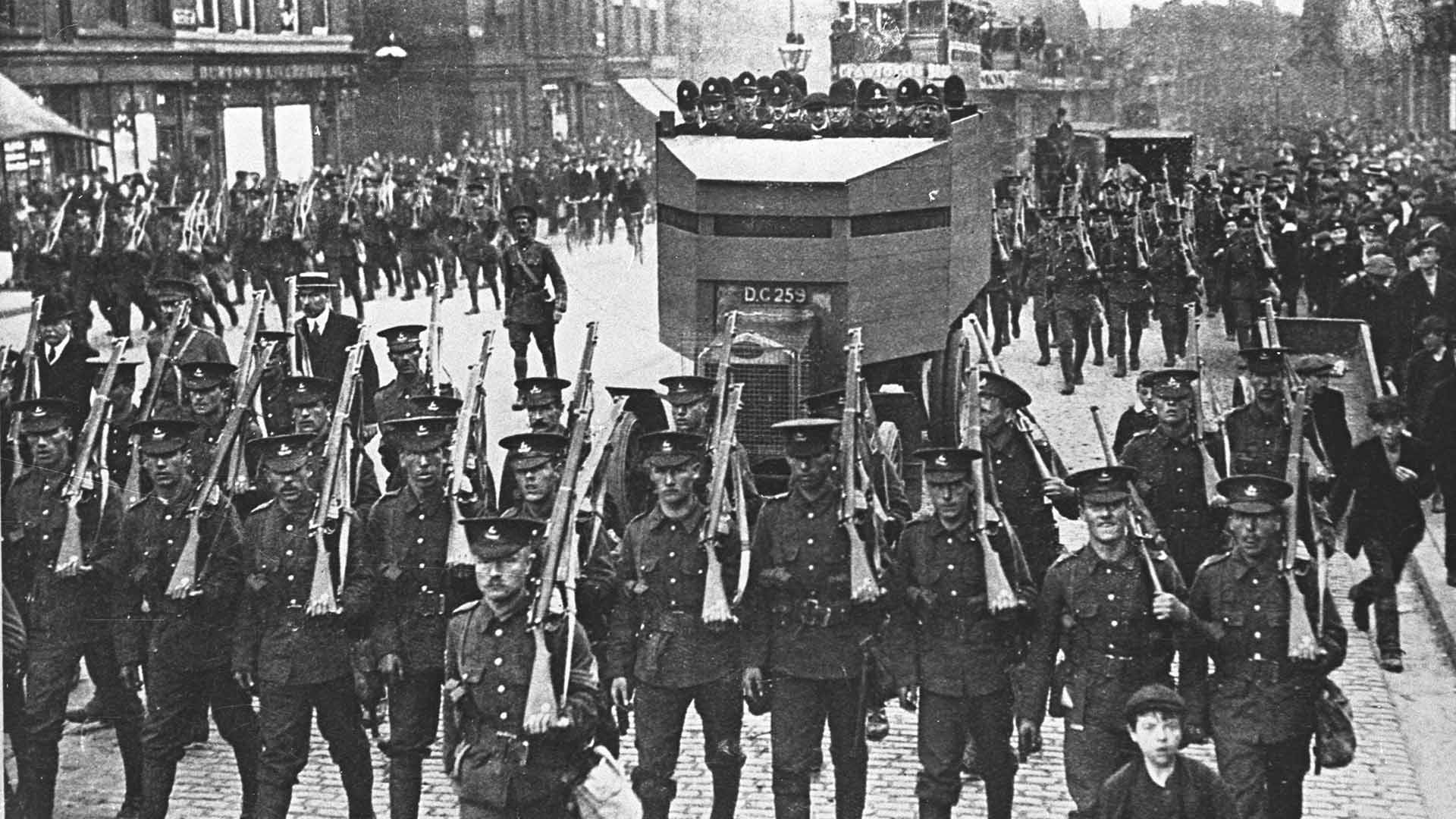 Escorted by troops and followed by a convoy of tramcars the Liverpool police sally forth in their protected Hallford lorry.
Escorted by troops and followed by a convoy of tramcars the Liverpool police sally forth in their protected Hallford lorry.With the evolution of military technology, so did the capabilities of British wheeled vehicles. World War II brought enhanced features, such as rotating turrets and bigger guns, bringing a new dimension to battlefield dynamics by offering a balance of speed, maneuverability, and firepower. The vehicles still provided reconnaissance and patrol capabilities but allowed for greater mobility on various terrains.
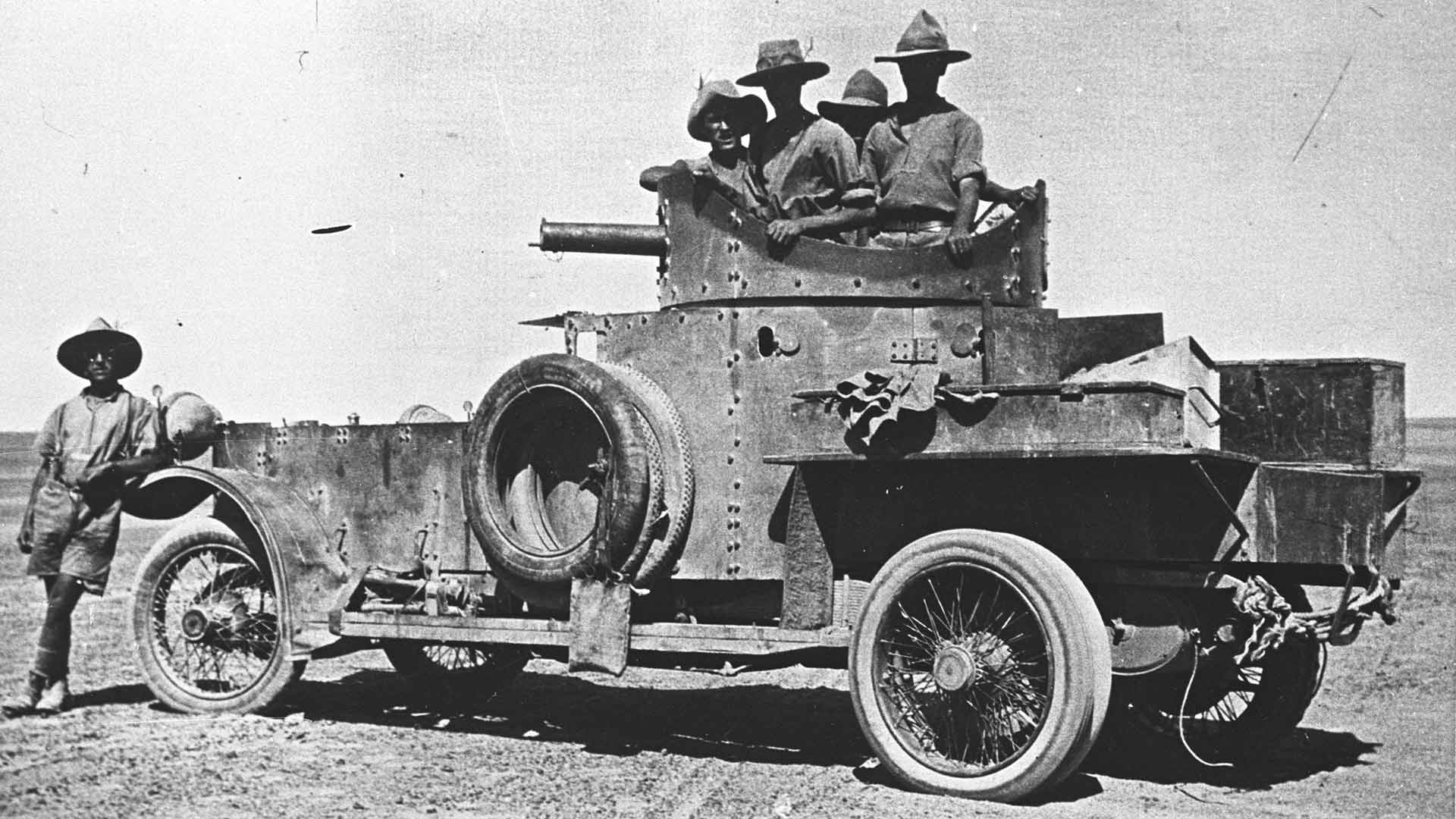 Anzac soldiers pose in and around a Rolls-Royce in the Western Desert. This car has had the armor from the top of the bonnet and turret as a concession to the heat.
Anzac soldiers pose in and around a Rolls-Royce in the Western Desert. This car has had the armor from the top of the bonnet and turret as a concession to the heat.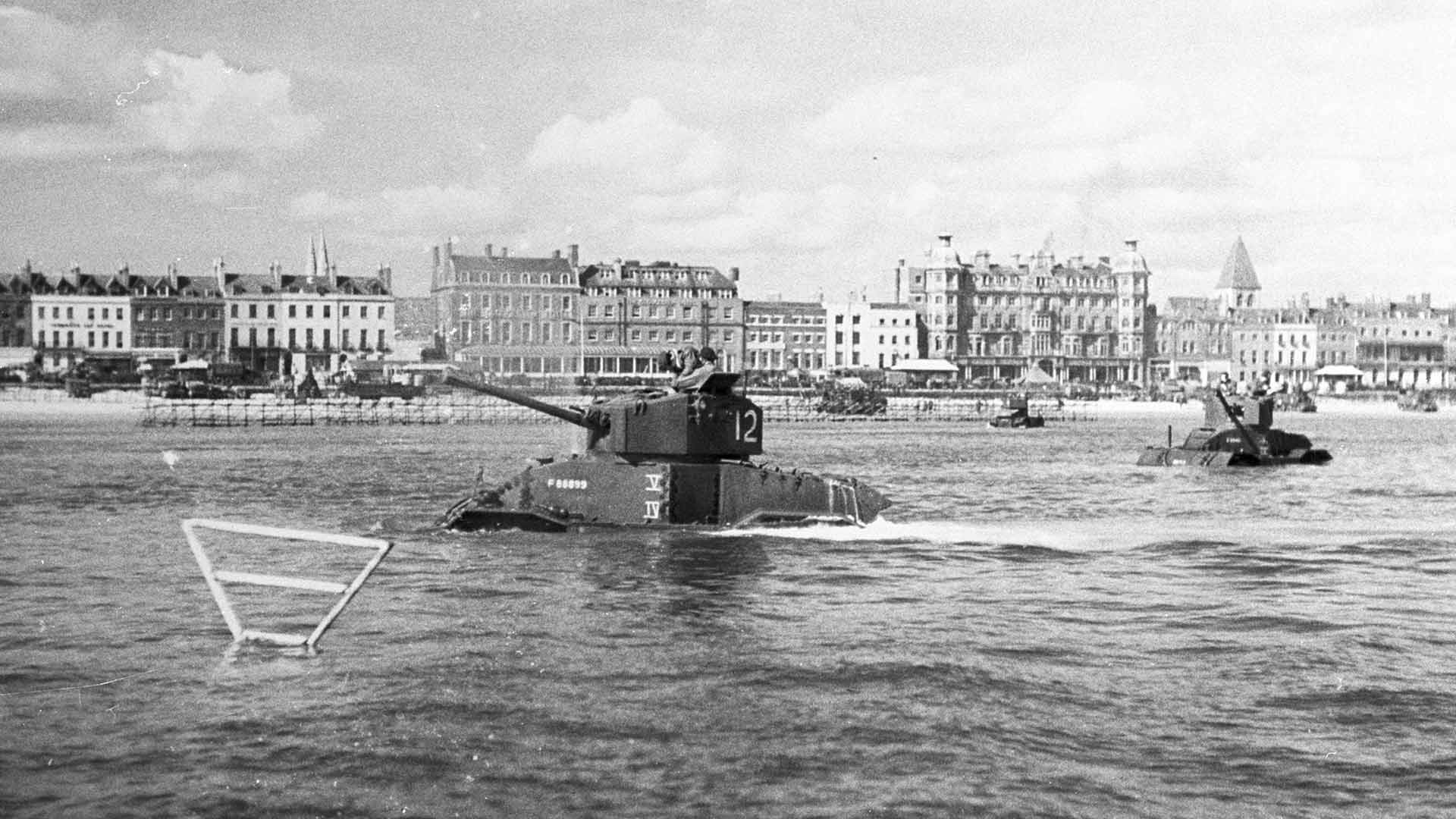 TEXT.
TEXT.The onset of the Cold War forced British wheeled vehicles to evolve and adapt to changing military doctrines and technological advancements. Thanks to advanced armament and better protection, they transitioned from purely reconnaissance roles to a wider array of functions like armored support and counter-insurgency operations.
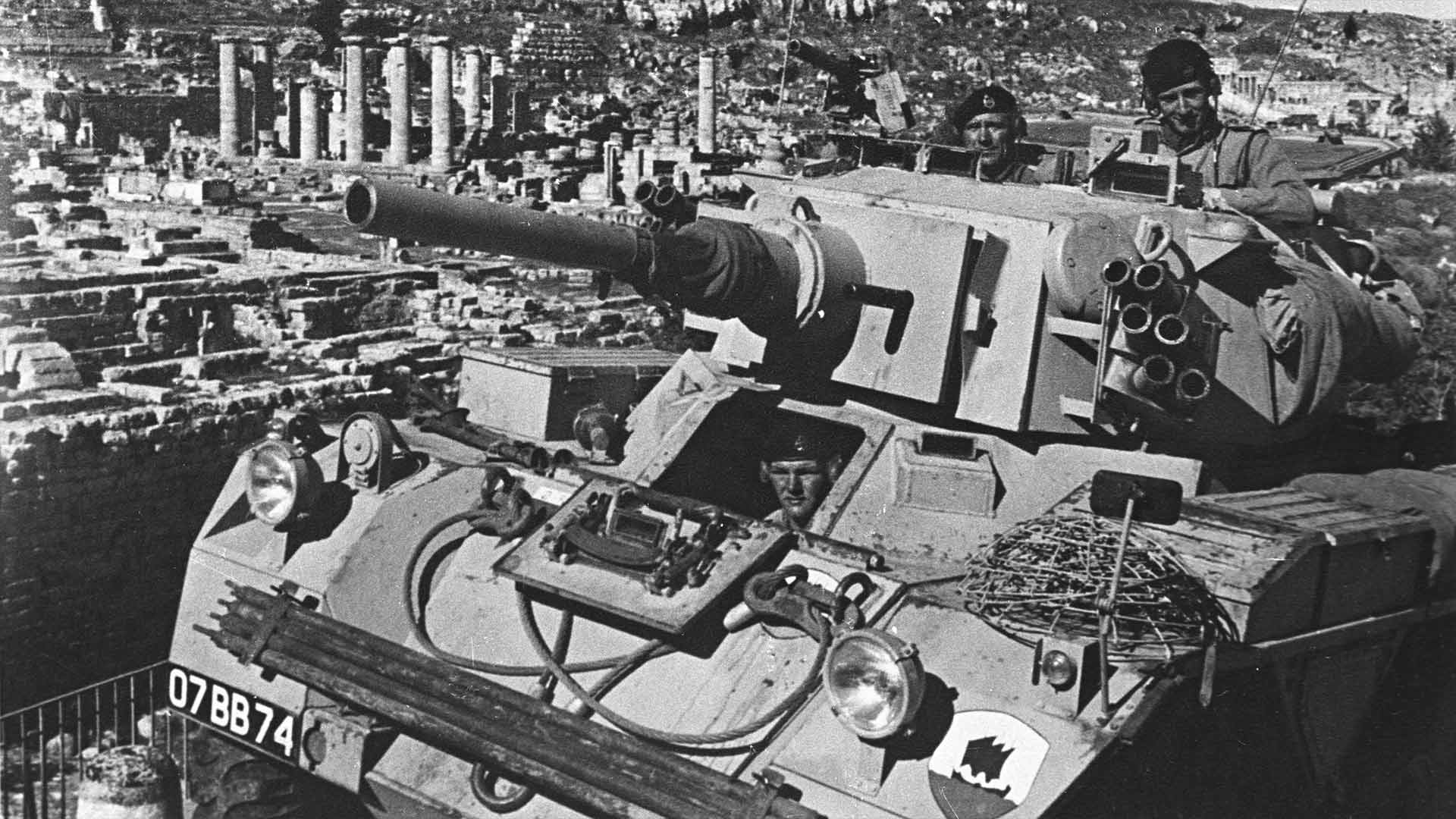 Saladin Mark 2, 2nd RTR, Cyrene, Libya.
Saladin Mark 2, 2nd RTR, Cyrene, Libya.
A Timeline of Armored British Wheeled Vehicles
With the introduction of historical British Wheeled vehicles into World of Tanks, we present a retrospective of the developmental milestones of these machines.
- 1914
- 1922
- 1940
- 1941
- 1942
- 1943
- 1952
- 1959
- 1973
- 1996
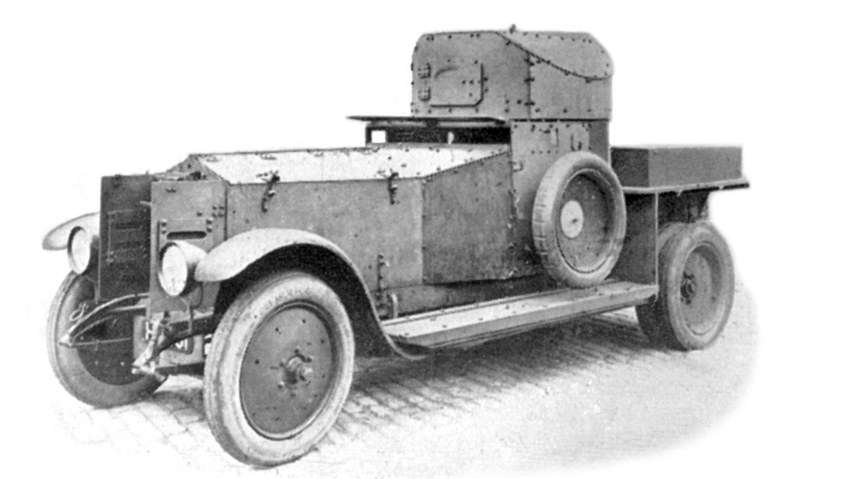 The Rolls-Royce Armoured Car.
The Rolls-Royce Armoured Car.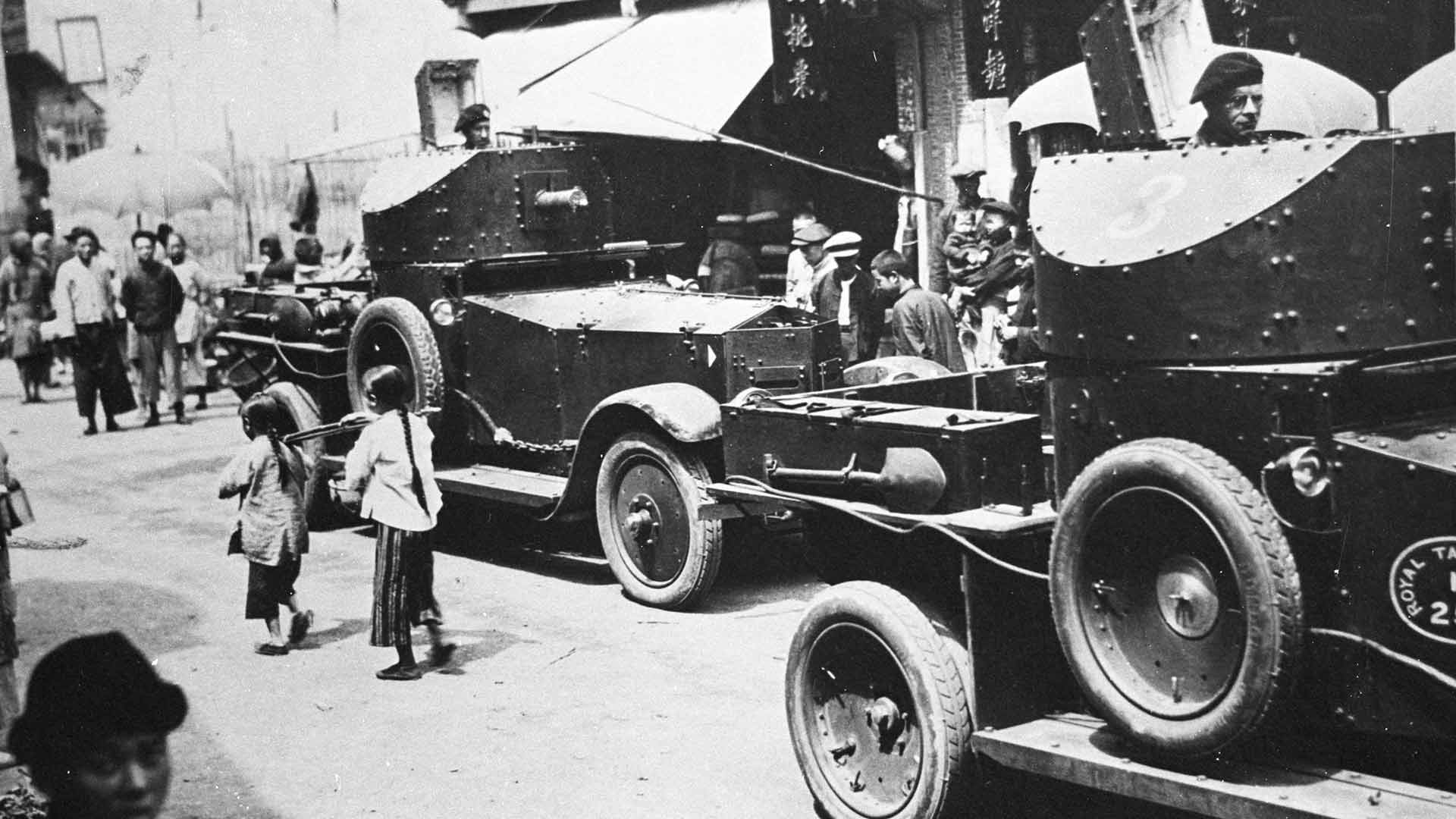 Two 1920 Pattern Rolls-Royce of 5th Armoured Car Company (ACC) in Shanghai. Their Top Hats are readily visible, and it is just possible to make out the front bumper on the rearmost car, both local additions.
Two 1920 Pattern Rolls-Royce of 5th Armoured Car Company (ACC) in Shanghai. Their Top Hats are readily visible, and it is just possible to make out the front bumper on the rearmost car, both local additions.1914: The Rolls-Royce Armoured Car enters service in World War I. Manufactured by the famed company of luxury automobiles, and armed with single or twin machine guns, it was developed in response to the need for armored vehicles capable of performing reconnaissance, scouting, and support roles on the battlefield.
Used by the Royal Naval Air service, the vehicle saw action in a variety of battle zones, such as North Africa and the Middle East. It was also successfully utilized by T.E. Lawrence (of Arabia) during his exploits against Turkish forces. The vehicle had limited success in Europe, primarily due to the conditions of trench warfare.
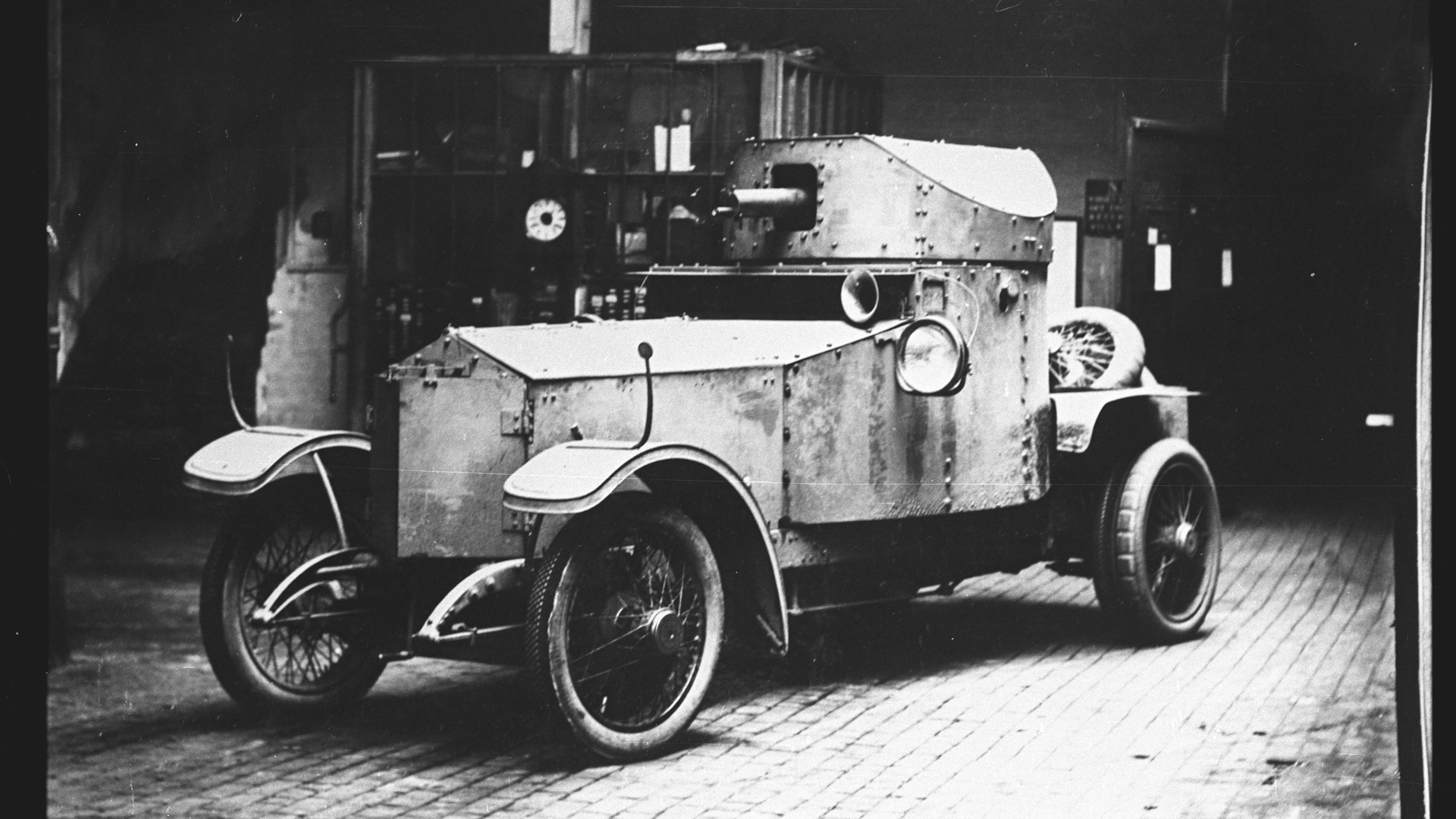 The prototype of the famous turreted Admiralty pattern Rolls-Royce armored car.
The prototype of the famous turreted Admiralty pattern Rolls-Royce armored car.1922: The Rolls-Royce Armoured Car returned to service during the Irish Civil War. Although outdated, the vehicle assisted the pro-Treaty National Army in its struggle against anti-Treaty forces by performing reconnaissance, transporting troops, and functioning as a machine gun platform to support infantry.
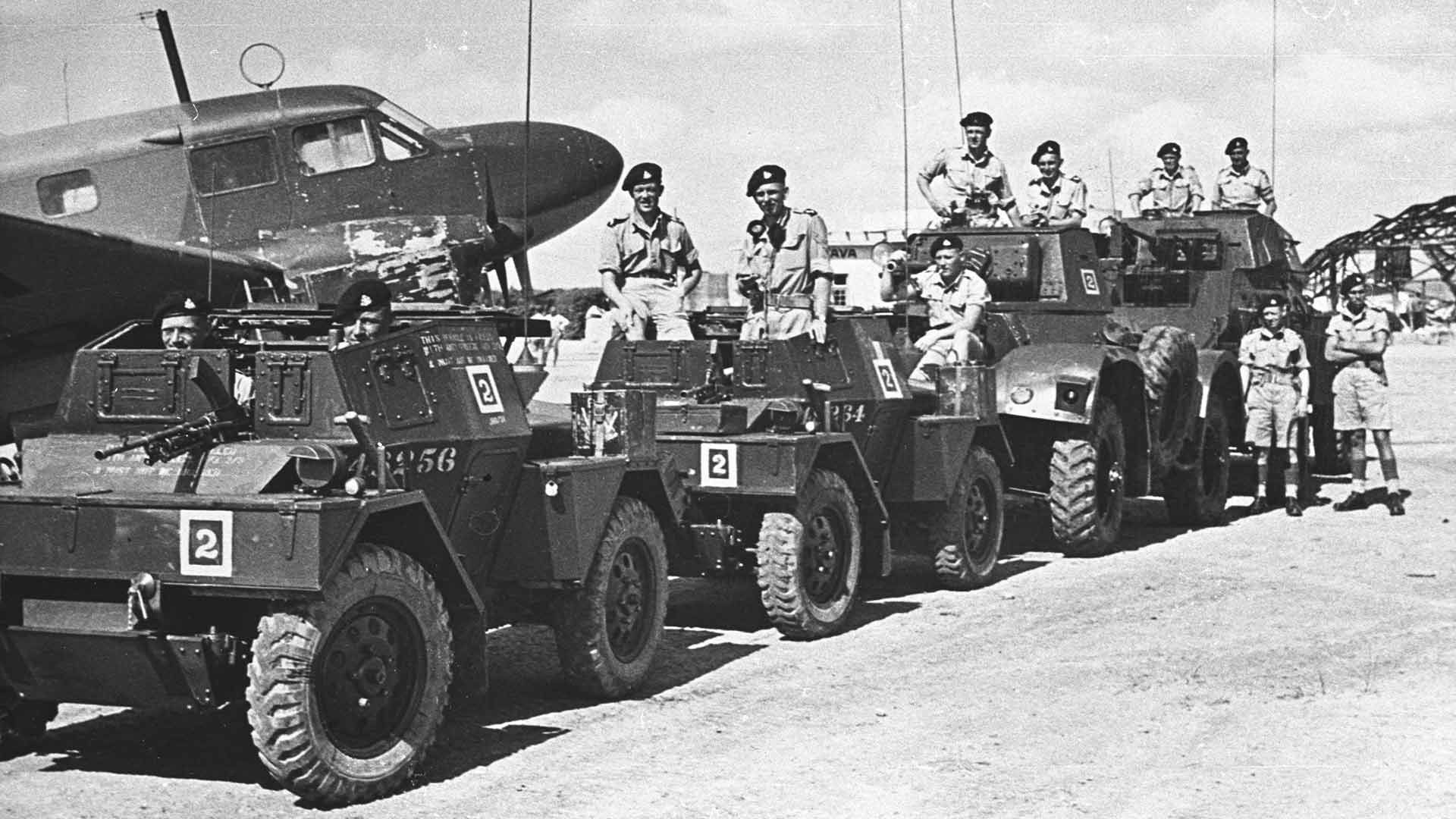 Daimler Dingo scout cars, a Daimler and Humber armoured car of 2nd Derbyshire Yeomanry, formed up in front of a Avro Anson on a North African airfield.
Daimler Dingo scout cars, a Daimler and Humber armoured car of 2nd Derbyshire Yeomanry, formed up in front of a Avro Anson on a North African airfield.1940: The Daimler Scout Car enters service. A two-person armored car manufactured by Daimler, the "Dingo" was well-regarded for its reliability and effectiveness in reconnaissance missions. The vehicle's compact size allowed it to navigate areas that were inaccessible to larger vehicles, but the versatile design allowed it to fill other roles—such as a liaison vehicle and a command car. More than 6,000 vehicles were produced until it was discontinued in 1974.
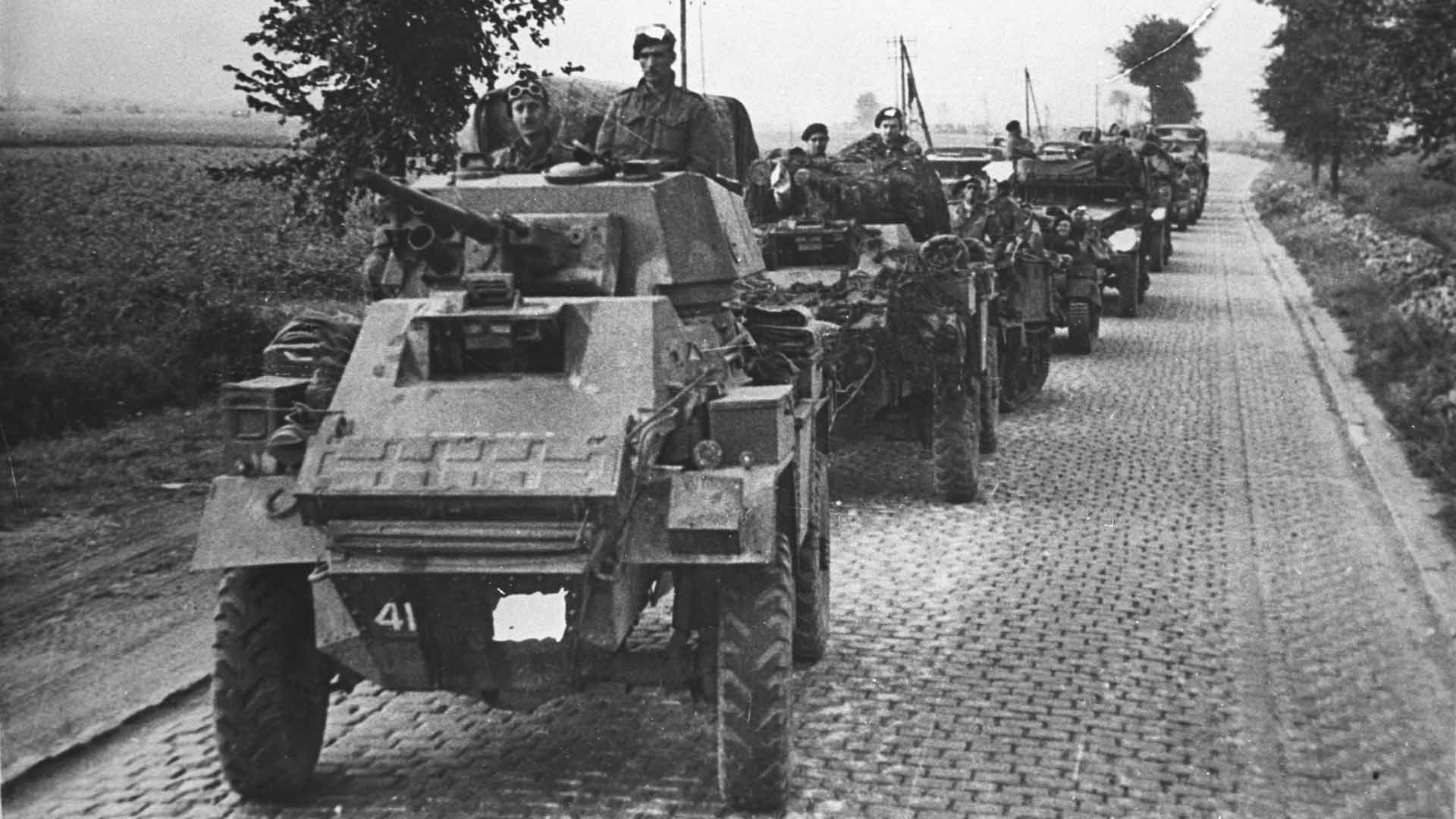 A 37mm gun Humber Mark IV armored car of C Squadron, 15th (Scottish) Recce Regiment leading No. 11 Troop, a mixed column of carriers and half-tracks, near the Belgian frontier in 1944.
A 37mm gun Humber Mark IV armored car of C Squadron, 15th (Scottish) Recce Regiment leading No. 11 Troop, a mixed column of carriers and half-tracks, near the Belgian frontier in 1944.1941: Humber Armoured Car hits the battlefield. Manufactured by the Rootes Group, the 4x4 vehicle was initially armed with machine guns, but later carried a 37 mm cannon. In June 1944, approximately one week after the June 6 landings, the Humber armored car arrived on the Normandy beaches. Favored for its mobility and speed, the vehicle aided in the Allied advance with reconnaissance, patrolling, and other duties. Approximately 5,400 were produced by the time it was discontinued in 1945 when World War II ended.
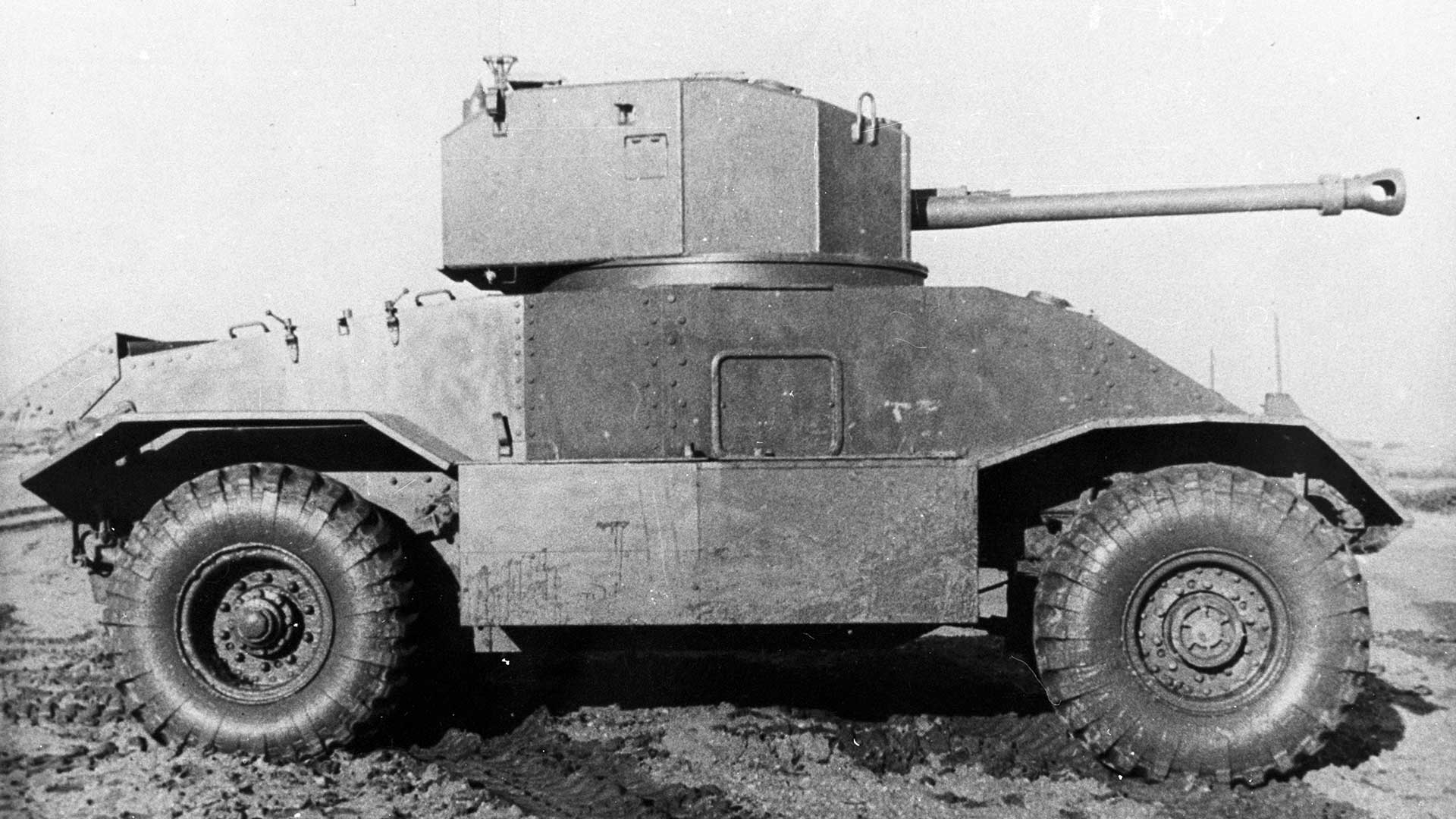 The AEC Mark III armored car with a 75 mm cannon.
The AEC Mark III armored car with a 75 mm cannon.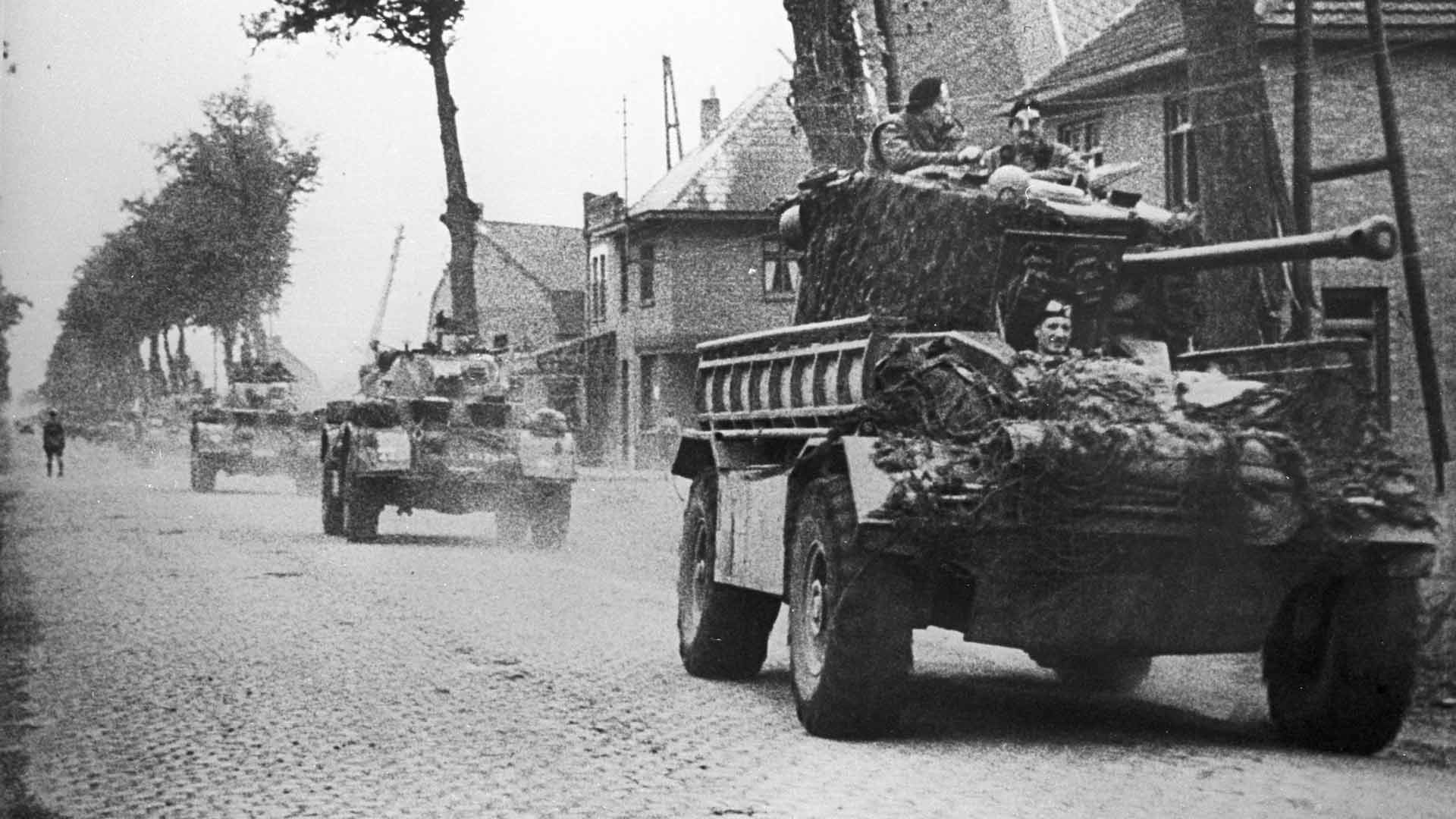 A 75mm gun AEC Mark III armored car leading staghounds of the 2nd Battalion, the Household Cavalry in Holland.
A 75mm gun AEC Mark III armored car leading staghounds of the 2nd Battalion, the Household Cavalry in Holland.In 1942, the AEC Armoured Car entered service. In World of Tanks, it's the first British Medium Wheeled vehicle in the Tech Tree, one of three models based on the original. AEC, known for crafting truck and bus chassis, created the Matador artillery tractor used to tow field and anti-aircraft guns. Building on this, an armored car was unveiled in 1941. Winston Churchill was impressed and a contract for 120 vehicles followed. Around 629 were made before production ceased in 1943.
The vehicle came in three primary versions: Mk. I (used the Valentine Mk. II tank turret), Mk. II (featured a redesigned front hull, 158 horsepower engine, and a heavier turret that carried a 6-pounder gun), and the Mk. III (armed with a 75 mm cannon). Thanks to its 4x4 wheel configuration, the AEC Armoured Car retained a hallmark of British Wheeled vehicles: Mobility. It could traverse diverse terrains, aiding its reconnaissance missions and patrolling duties. It also played a vital role in collaboration with infantry units, offering mobile fire support and relaying real-time information through its communication equipment.
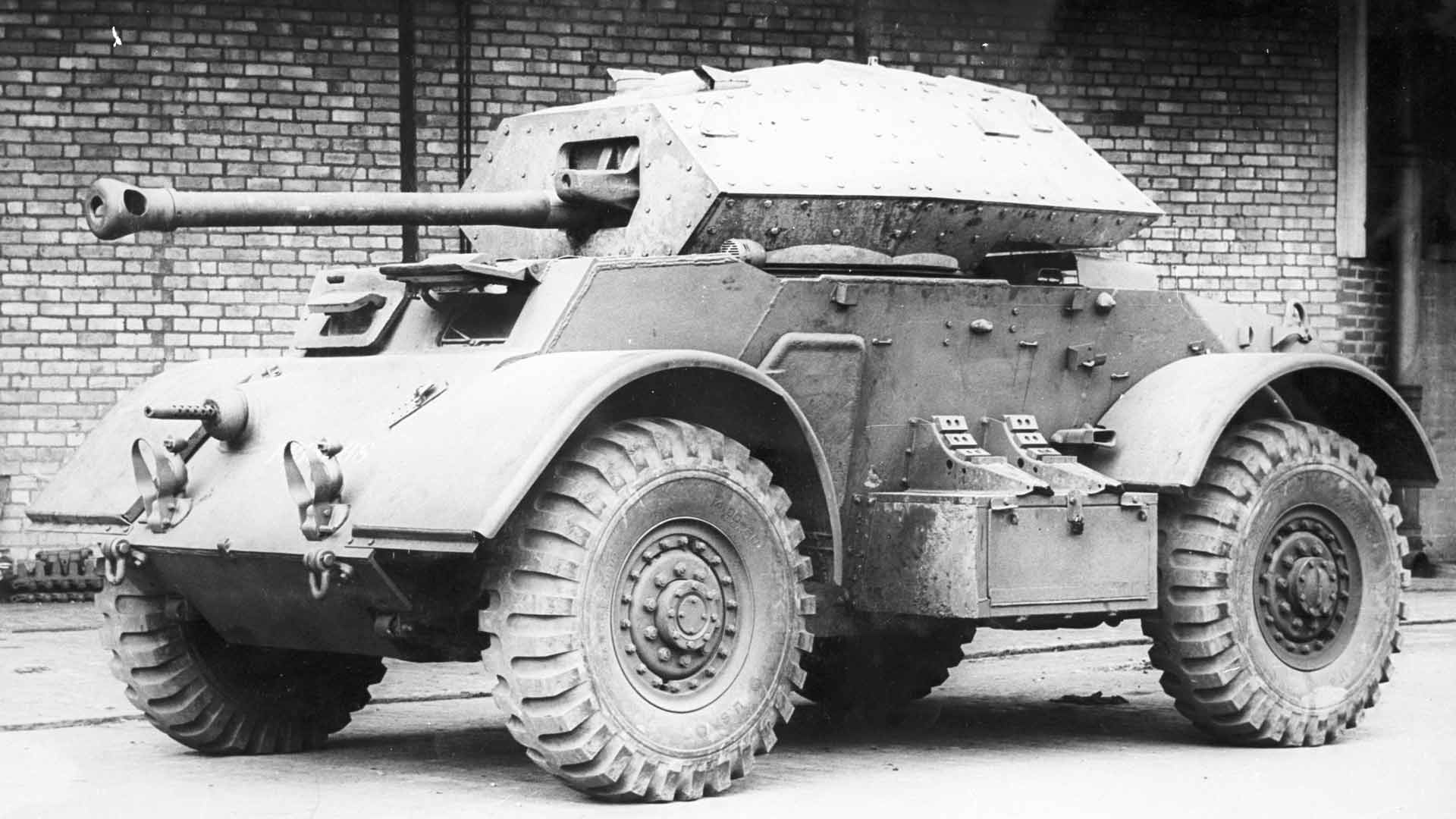 The overpowering effect of a 75mm Crusader turret fitted to the Staghound hull. The hull machine-gun, not normally fitted to a Staghound III, suggests that this might be the prototype conversion.
The overpowering effect of a 75mm Crusader turret fitted to the Staghound hull. The hull machine-gun, not normally fitted to a Staghound III, suggests that this might be the prototype conversion.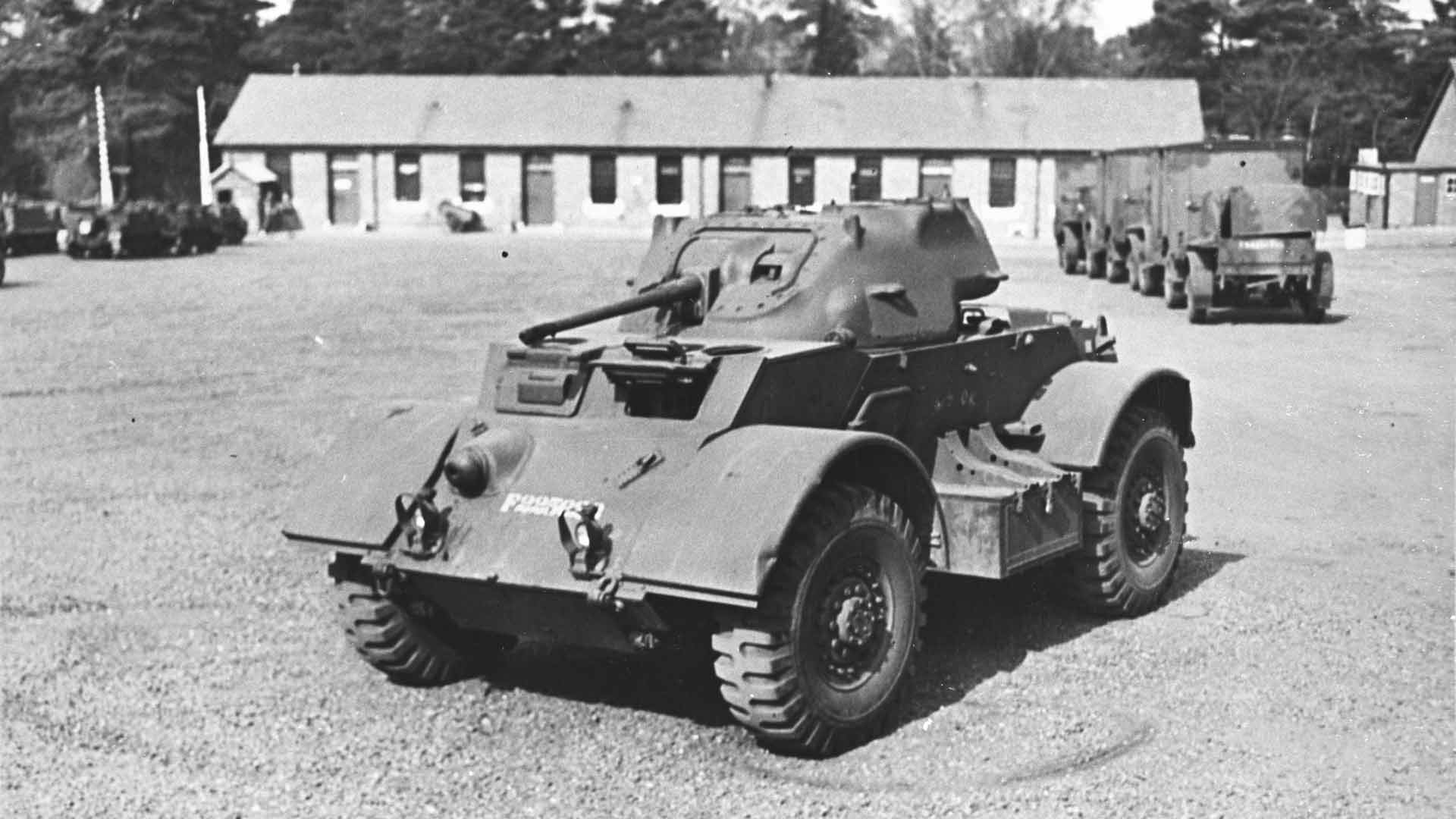 The Staghound with an Mk. II turret.
The Staghound with an Mk. II turret.In 1943, the Staghound Mk. I was introduced, a British vehicle made in the U.S. by Chevrolet under Lend-Lease. It saw action in North Africa, Europe, and the Pacific, excelling in roles like reconnaissance and fire support. Its mobility matched with 37mm or 75mm M6 guns, and the Mk. III even used a Crusader tank turret. In World of Tanks, the Staghound Mk. III is on the British Tech Tree at Tier VI.
An estimated 3,844 Staghounds were produced from 1942-1944. Although production lasted for a year, the vehicle and its variants were later used in the Arab-Israeli War (1948), Cuban Revolution (1953-1959), Vietnam (1955-1975), and other conflicts.
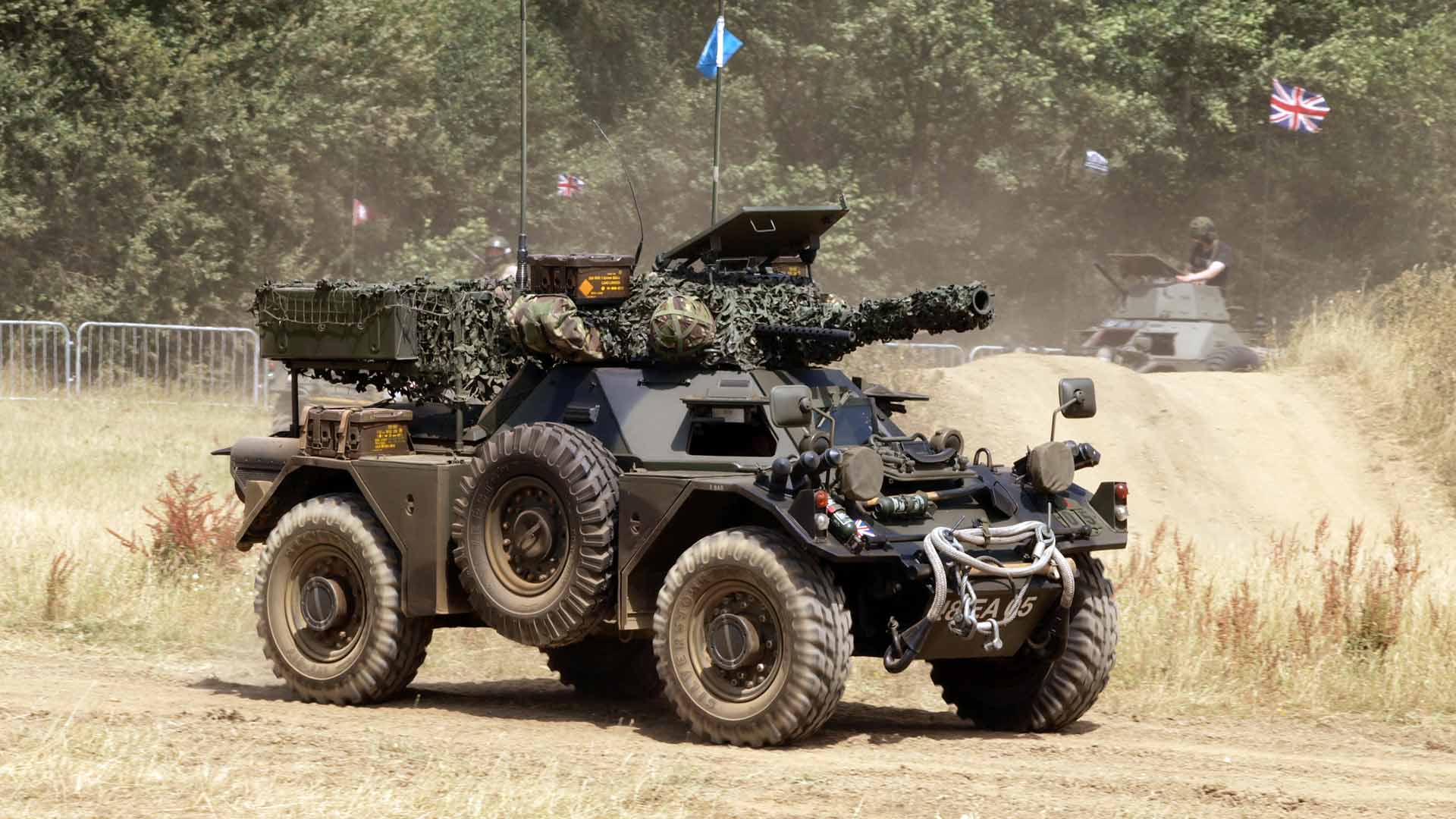 Ferret Scout Car at the War and Peace Show 2010.
Ferret Scout Car at the War and Peace Show 2010.1952: The Ferret Scout Car enters service. Manufactured by Daimler, it was powered by a Rolls-Royce 130 horsepower engine that gave it a top speed of 58 km/h, and it was effective at off-road maneuvers. Its small size made it easily transportable by air. The two-person vehicle was armed with a .30 caliber machine gun that was mounted in a turret. The Ferret was retired in 1991 after almost 40 years of service, with approximately 4,500 units built.
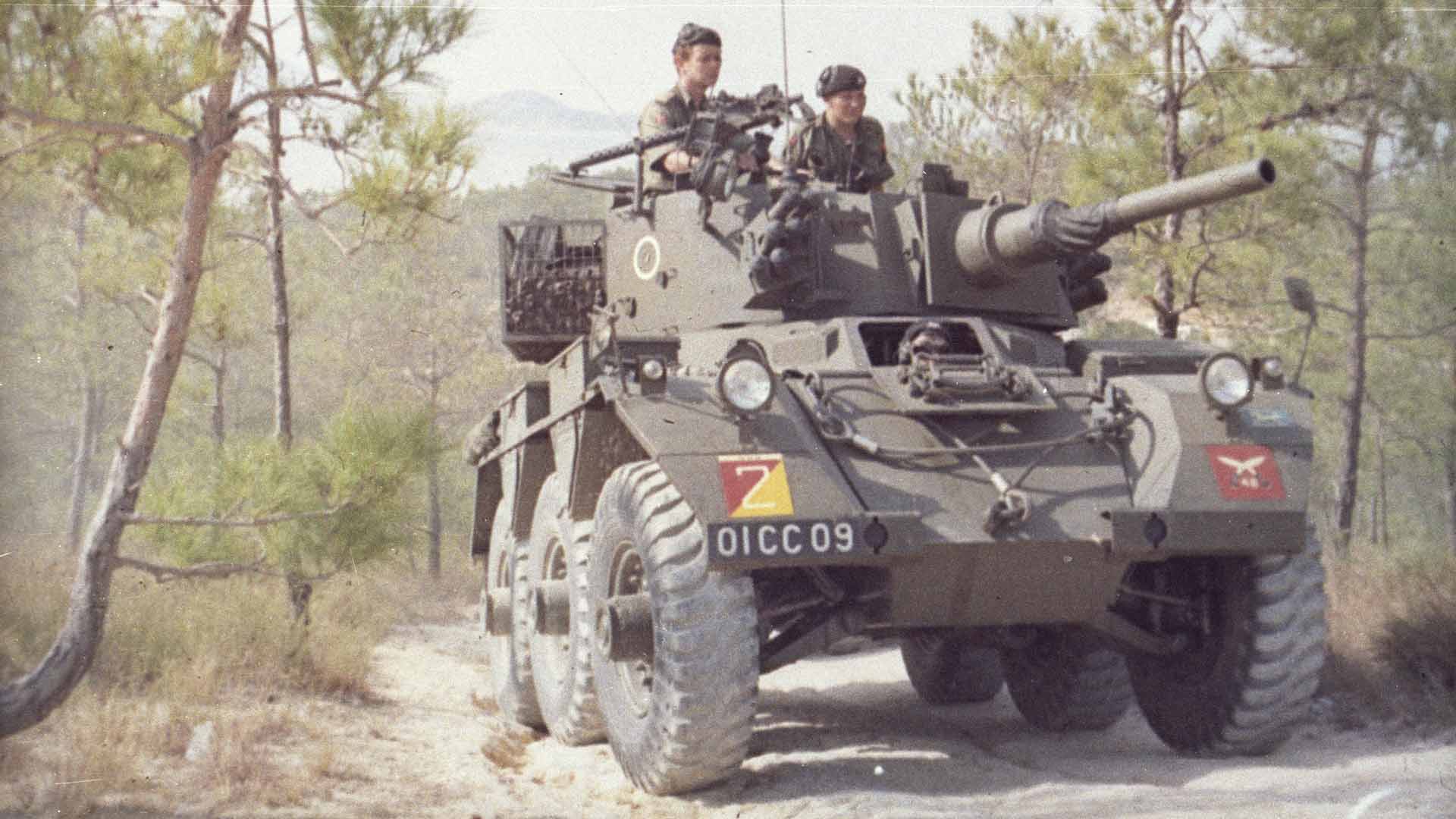 Saladin with 48th Ghurka Brigade in Mayala.
Saladin with 48th Ghurka Brigade in Mayala.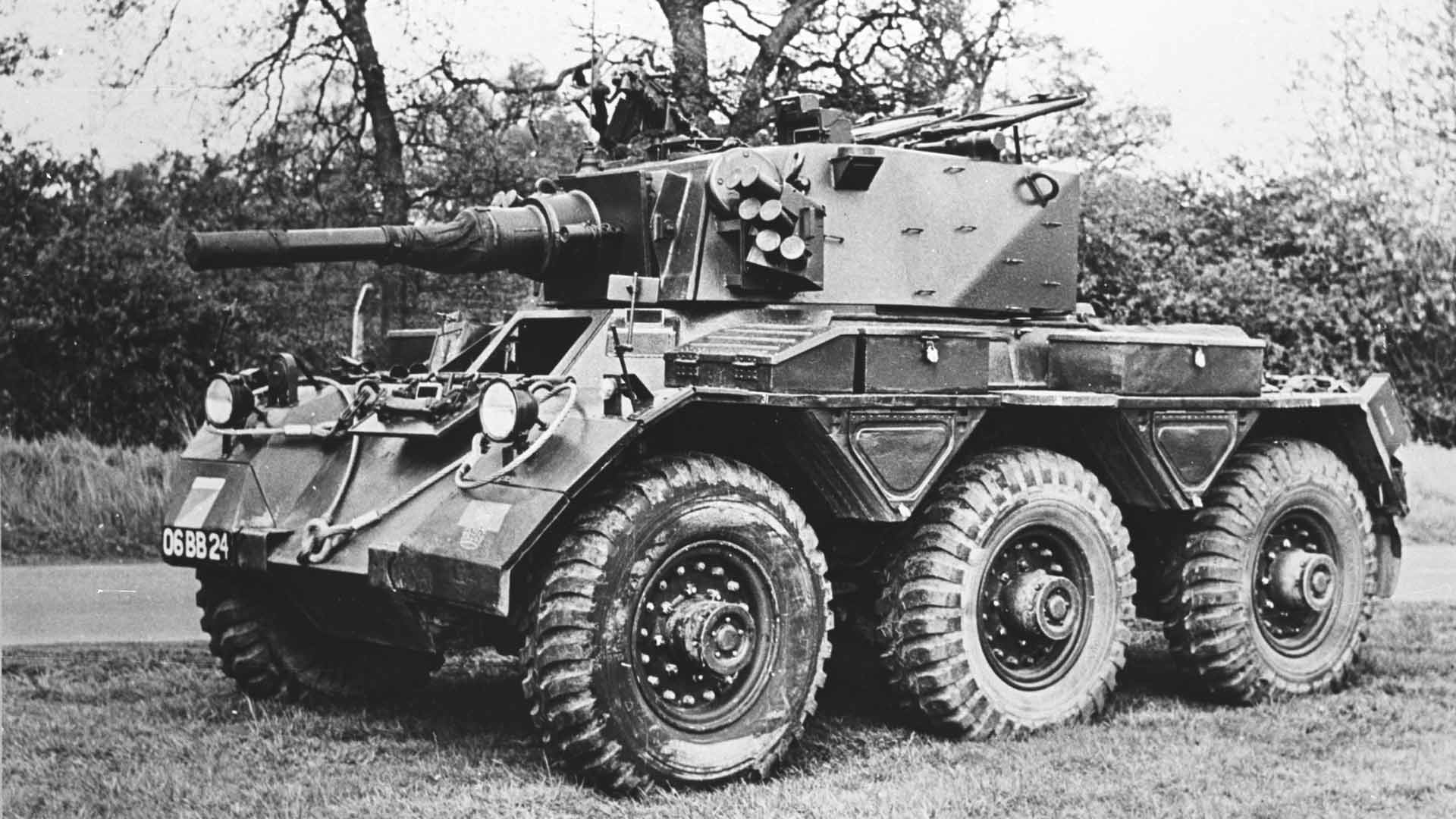 The FV106 Saladin with 76 mm cannon.
The FV106 Saladin with 76 mm cannon.In 1959, the FV601 Saladin debuted, a Crossley Motors creation made by Alvis Car and Engineering Company in the Cold War. With a Rolls-Royce engine (170 horsepower) propelling its six-wheeled (3x3) frame, the Saladin combined mobility, firepower, and adaptability, serving in recon and fire support. Armed with a potent 76mm high-velocity gun and a coaxial machine gun, it excelled against armor and infantry. Beyond Britain, nations like Australia and Jordan adopted it. In World of Tanks, it sits on the Tech Tree at Tier VIII.
The vehicle saw action in several notable worldwide conflicts during its lifespan. These included the Aden Emergency (1963-1967), Northern Ireland Conflict (1966-1998), Six-Day War (1967), and Turkish Invasion of Cyprus (1974)—among others. In these instances, Saladin illustrated the vital role agile wheeled platforms could play in modern conflicts. Approximately 1,177 Saladin armored vehicles were built by the time it ceased production in 1972.
_pic4_1920_new.jpg) FV721 Fox CVRW (Combat Vehicle Reconnaissance (Wheeled)) at the War and Peace Show 2010.
FV721 Fox CVRW (Combat Vehicle Reconnaissance (Wheeled)) at the War and Peace Show 2010.1973: FV721 Fox CVRW (Combat Vehicle Reconnaissance (Wheeled)) is introduced. Manufactured by Alvis PLC, the four-wheeled vehicle was considered a replacement for the Ferret and Saladin. It served as a scouting vehicle, primarily for light reconnaissance duties and was powered by a rear-mounted Jaguar engine with 190 horsepower that could reach a 64.6 km/h top speed. Atop its fully rotating turret was a 30 mm cannon. The vehicle saw action in Operation Desert Storm/Shield during the Gulf War (1990-91). The vehicle was discontinued in 1993.
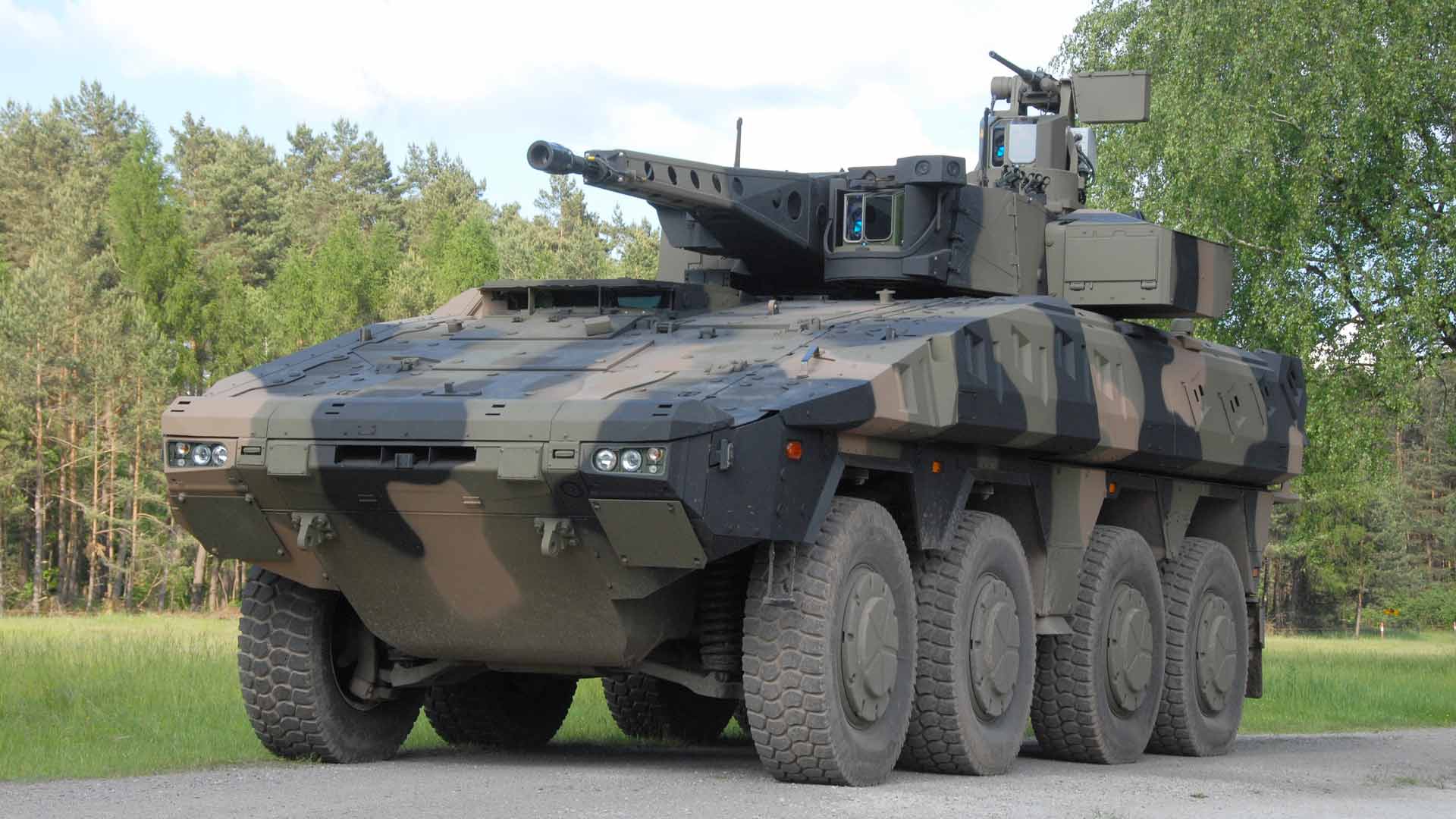 A Boxer configured for Australian Land 400 Phase 2.
A Boxer configured for Australian Land 400 Phase 2.1996: The United Kingdom joins the Boxer project. Although started by France and Germany in 1993, the U.K. joined development of the vehicle three years later, withdrew in 2003, then re-joined in 2018. The vehicle is a marvel in versatility: Rolling on eight wheels and powered by engines that range in 711-850 horsepower, the Boxer can fill several roles thanks to "mission modules:" Self-contained units that can be quickly exchanged on the vehicle's chassis. Each module is designed to cater to a specific function or role, such as troop transport, medical evacuation, reconnaissance, fire support (armaments include machine guns, anti-aircraft, cannons, and guided missiles), and more.
Creating British Wheeled Vehicles in World of Tanks
The development of British Wheeled Vehicles in World of Tanks was a meticulous four-year endeavor, uniting historical accuracy with captivating gameplay. It began with the journey of incorporating real-life vehicles and blueprints into the virtual landscapes, marked by significant milestones.
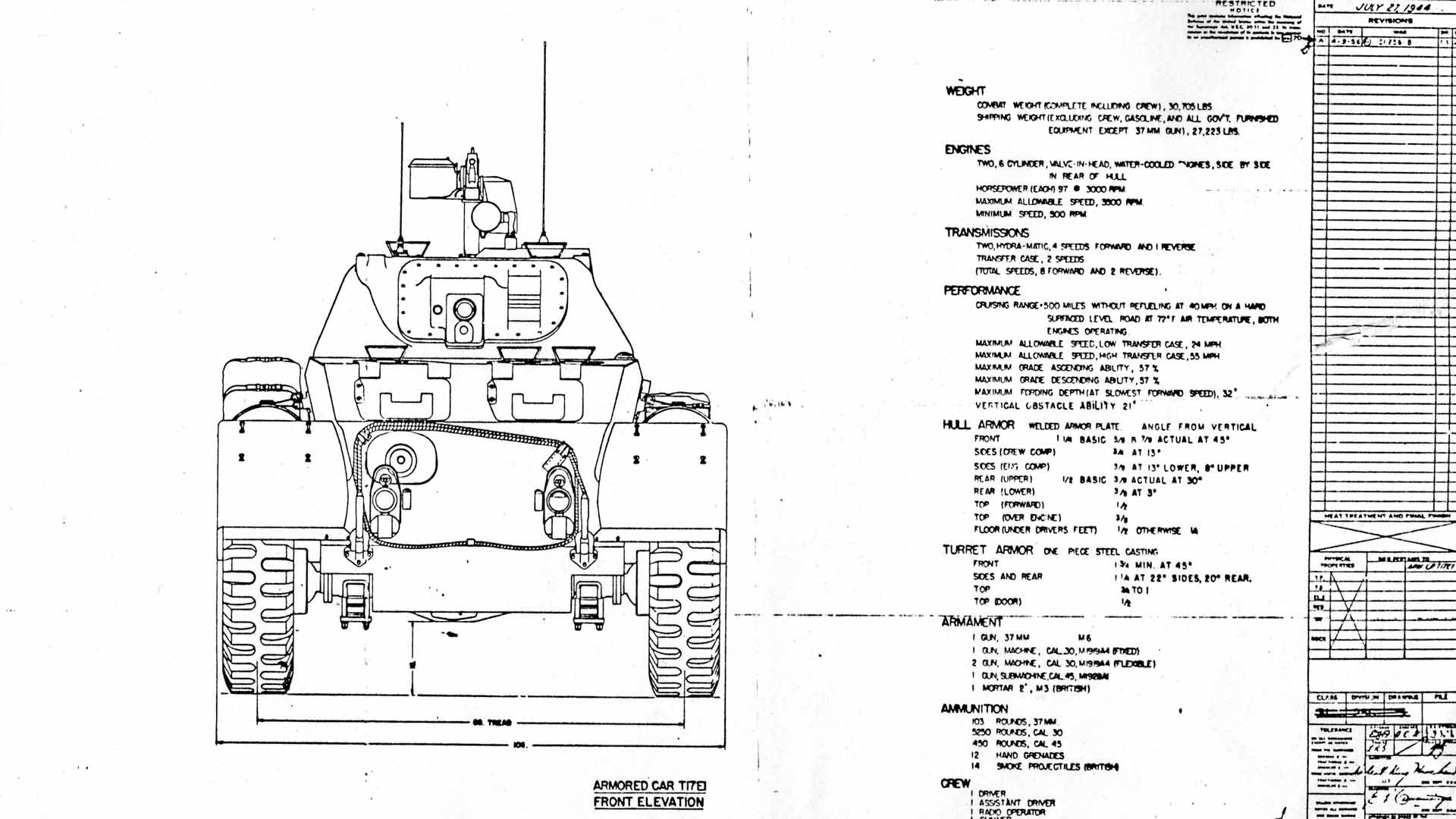 A blueprint of the Staghound showing the front of the vehicle and all its specifications.
A blueprint of the Staghound showing the front of the vehicle and all its specifications. A profile blueprint of the Staghound featuring cut-away details of various components.
A profile blueprint of the Staghound featuring cut-away details of various components.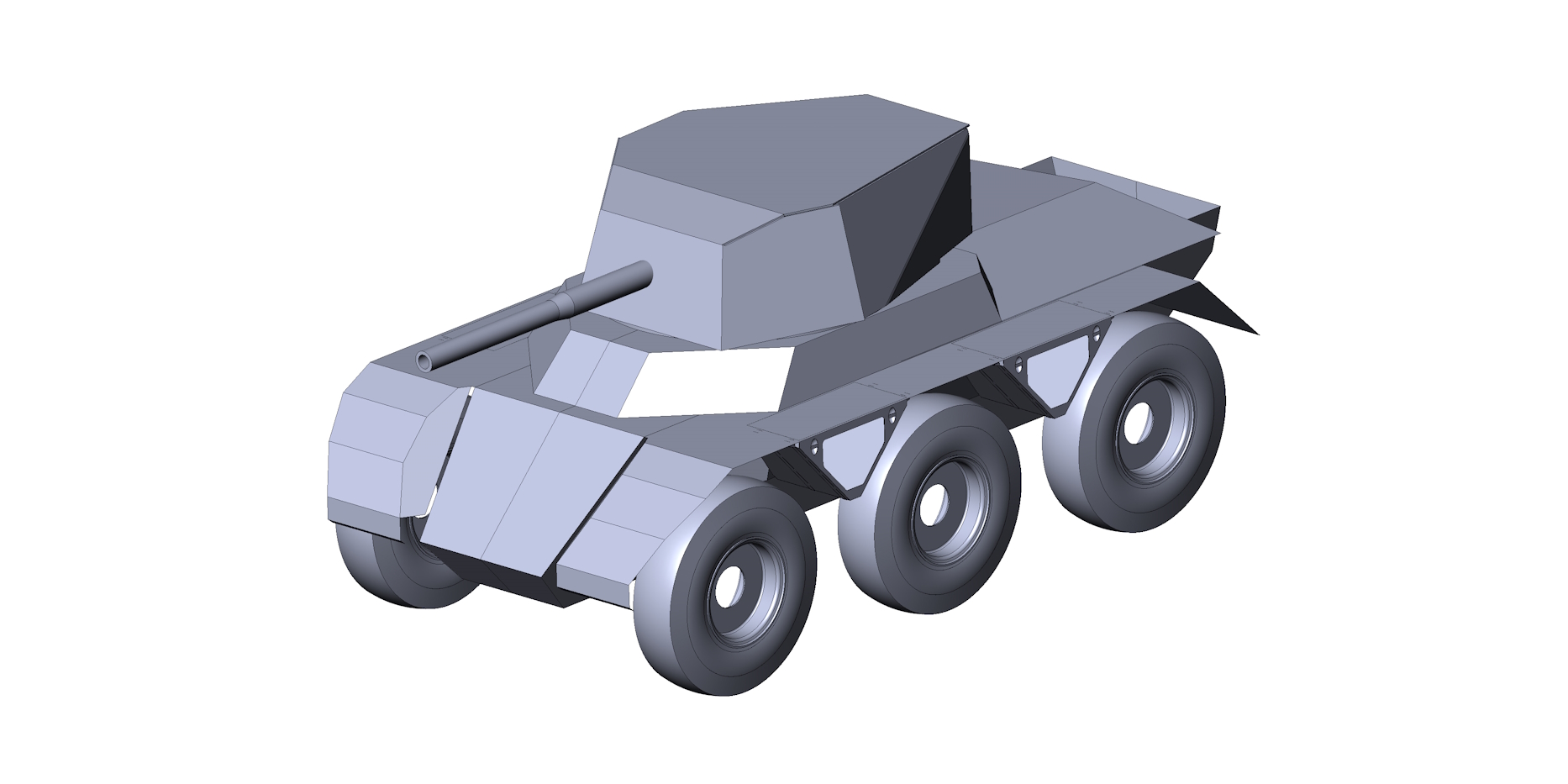

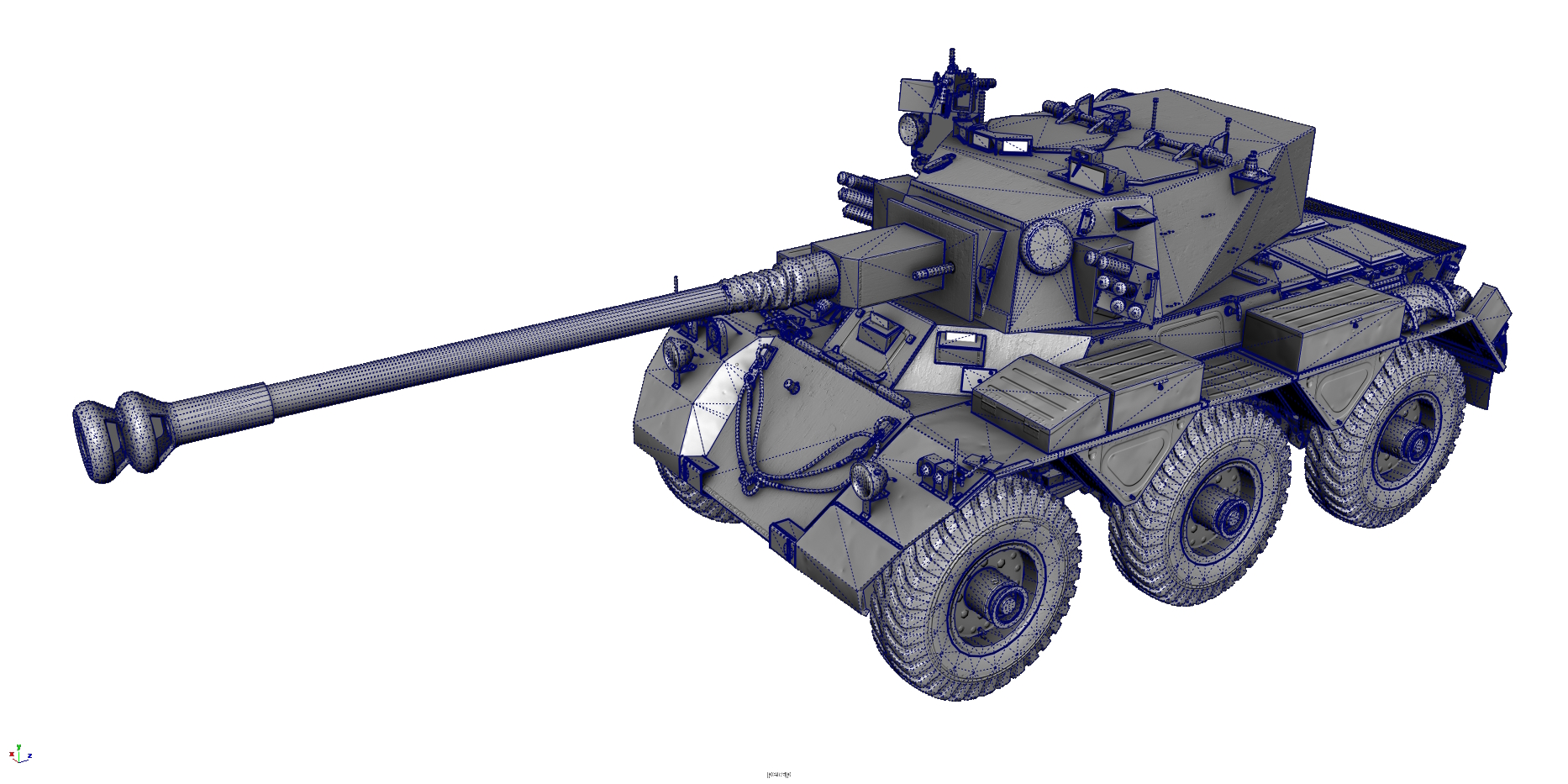
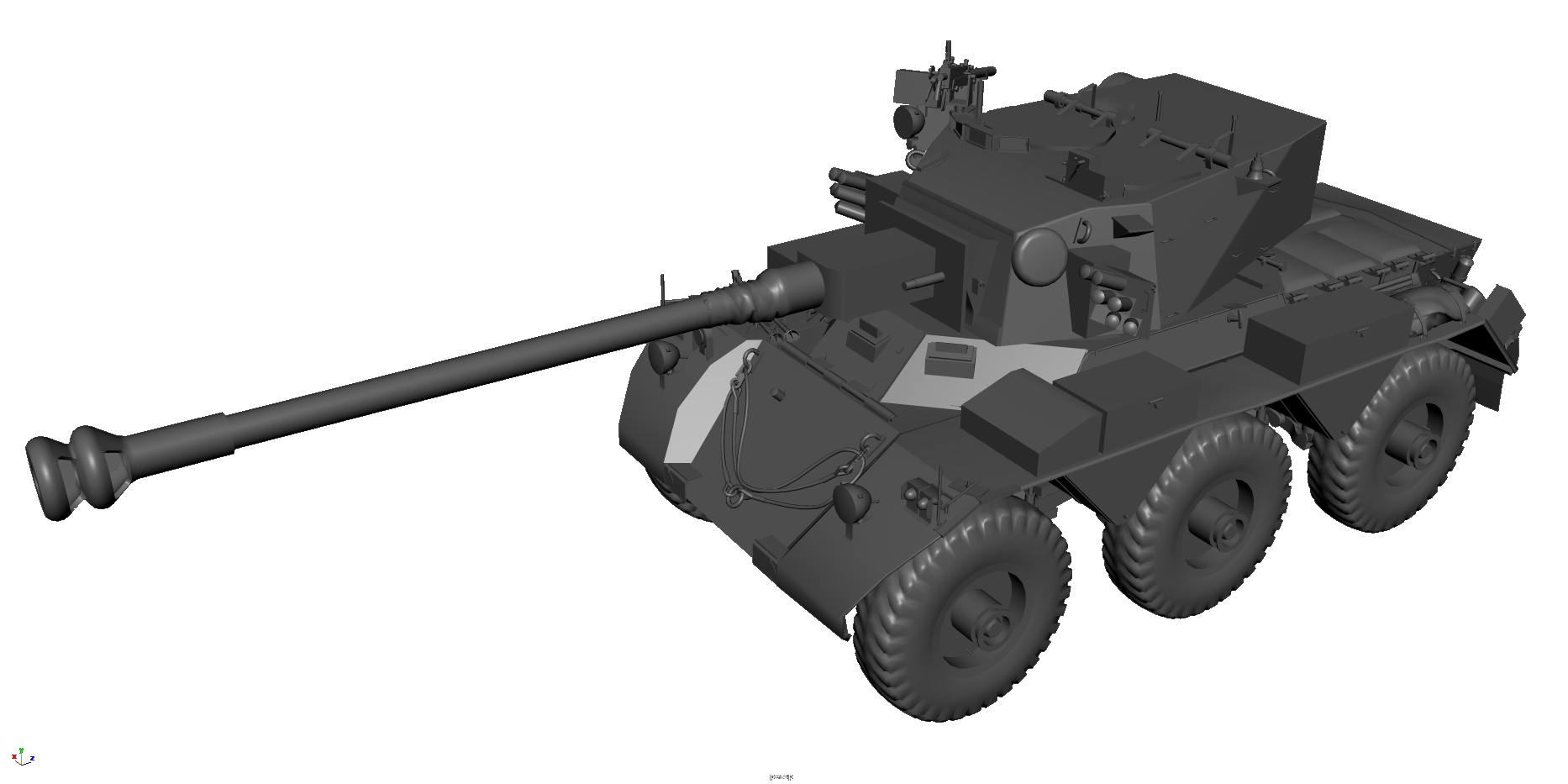
1. Conceptualization and Ideation:
The journey commenced with brainstorming innovative gameplay mechanics and ideas.
2. Machine Selection and Branch Construction:
The selection of appropriate machines formed the cornerstone for creating new branches or modules, each enriched with distinctive technologies.
3. Engineering-Driven Modeling:
Chosen machines underwent precise modeling based on engineering principles to ensure realistic and authentic representations.
4. Historical Collaboration:
In a crucial phase, we delved into archives, blueprints, sketches, and even employed 3D scans where possible. In collaboration with the esteemed Tank Museum in Bovington, UK, this meticulous research ensured unparalleled authenticity for the British Wheeled Vehicles.
5. Adaptation for Game Engine:
The journey culminated in the seamless integration of high-poly 3D models into the game engine, ensuring a realistic gaming experience.
6. Technical Setup and Testing:
A robust technical framework was established to facilitate the smooth functioning of the 3D models within the game, with rigorous testing validating model performance.
7. Gaming Parameters Configuration:
Attributes and behaviors of the virtual British Wheeled vehicles were fine-tuned, delivering an immersive gameplay experience.
8. Final Release:
After meticulous development and testing, with the release of update 1.22, the virtual tanks were ready for action on the virtual battlefield, embodying the harmonious blend of history and gameplay within World of Tanks.
Now You Know The History, Play the Vehicles!

Head to our "Roll, Britannia!" event! There is still time to earn fantastic themed rewards with special missions available for British wheeled medium vehicles until September 25!
Photo Credits
- All images are courtesy of the The Tank Museum, except for the following:
- Rolls-Royce Armoured Car 1920: This work created by the United Kingdom Government is in the public domain
- Ferret Scout Car: File is made available under the Creative_Commons CC0 1.0 Universal Public Domain Dedication
- FV721 Fox CVRW (Combat Vehicle Reconnaissance (Wheeled)): File is made available under the Creative_Commons CC0 1.0 Universal Public Domain Dedication
- Boxer: Graham Robson-Parker; file is licensed under the Creative_Commons Attribution-Share Alike 4.0 International license
